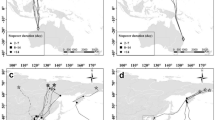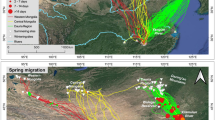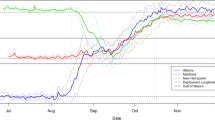Abstract
The Arctic is a highly seasonal environment with a harsh climate and extensive sea ice cover during the winter. Consequently, most Arctic-breeding seabirds migrate south to reach more benign environmental conditions. Knowledge of migration routes and wintering areas is integral for successful conservation of these globally important breeding populations. In this study, we deployed light-level geolocators on female common eiders Somateria mollissima breeding in Kongsfjorden, Svalbard, to track movements during the non-breeding season. We retrieved functioning loggers from 47 individual birds in 2009–2013 and mapped their migration routes and wintering areas. Thirty-six birds (77 %) wintered around the Icelandic coast and 11 (23 %) off the coasts of North Norway. Autumn migration took place between late August and late December, and spring migration from late March to late May. The migration (ca 1700 km to Iceland and 1300 km to North Norway) lasted for about 4 days in autumn and 3 days in spring. Later arrival resulted in later nest initiation, implying a carry-over effect of winter conditions on subsequent breeding. Birds that migrated to Norway departed later from Svalbard in autumn and consequently spent less time in the wintering area than individuals that migrated to Iceland. As just two countries, Iceland and Norway, appear to host all common eiders from Svalbard during the winter, the new information provided by this study on the core areas and timing of migration should provide the impetus for improved bilateral conservation management of this important Arctic breeding population of common eiders.



Similar content being viewed by others
References
Bakken V, Anker-Nilssen T (2012) Herkomst av sjøfugler langs norskekysten utenom hekkeperioden. Rapport til Oljeindustriens Landsforening. Det Norske Veritas, Arctic Research and Consulting (ARC) and SEAPOP. DNV rapport nr. 2013–1340
Bakken V, Runde O, Tjørve E (2003) Norsk ringmerkingsatlas vol1. Stavanger Museum, Stavanger
Berge J, Johnsen G, Nilsen F, Gulliksen B, Slagstad D (2005) Ocean temperature oscillations enable reappearance of blue mussels Mytilus edulis in Svalbard after a 1000 year absence. Mar Ecol Prog Ser 303:167–175
Bugoni L, D’Alba L, Furness RW (2009) Marine habitat use of wintering spectacled petrels Procellaria conspicillata, and overlap with longline fishery. Mar Ecol Prog Ser 374:273–285
Bustnes JO, Lønne OJ (1997) Habitat partitioning among sympatric wintering common eiders Somateria mollissima and king eiders Somateria spectabilis. Ibis 139:549–554
Bustnes JO, Tertitski GM (2000) Common eider Somateria mollissima. In: Anker-Nilssen T, Bakken V, Strøm,H, Golovkin AN, Bianki VV, Tatarinkova, IP(eds). The status of marine birds breeding in the Barents Sea region. Norsk Polarinstitutt Rapportserie nr. 113, Norsk Polarinstitutt, Tromsø, pp 46–50
Bustnes JO, Moe B, Herzke D, Hanssen SA, Nordstad T, Sagerup K, Gabrielsen GW, Borgå K (2010) Strongly increasing blood concentrations of lipid-soluble organochlorines in high-Arctic common eiders during incubation fast. Chemosphere 79:320–325
Bustnes JO, Moe B, Helberg M, Phillips RA (2013) Rapid long-distance migration in Norwegian lesser black-backed gulls Larus fuscus fuscus along their eastern flyway. Ibis 155:402–406
CAFF Circumpolar Seabird Working Group (1997) Circumpolar eider conservation strategy and action plan. Akureyri, Iceland, p 16
Calenge C (2006) The package adehabitat for the R software: a tool for the analysis of space and habitat use by animals. Ecol Model 197:516–519
Chaulk KG, Mahoney ML (2012) Does spring ice cover influence nest initiation date and clutch size in common eiders? Polar Biol 35:645–653
Cramp S (ed) (1992) The birds of the western Palearctic, vol VI. Oxford Univ. Press, Oxford
Del Hoyo J, Elliott E, Sargatal J (eds) (1992) Handbook of the Birds of the World, vol 1. Lynx Editions, Barcelona
Egevang C, Stenhouse IJ, Phillips RA, Petersen A, Fox JW et al (2010) Tracking of Arctic terns Sterna paradisaea reveals longest animal migration. Proc Natl Acad Sci USA 107:2078–2081. doi:10.1073/pnas.0909493107
Fauchald P, Anker-Nilssen T, Barrett RT, Bustnes JO, Bårdsen BJ, Christensen-Dalsgaard S, Descamps S, Engen S, Erikstad KE, Hanssen SA, Lorentsen S-H, Moe B, Reiertsen TK, Strøm H, Systad GH (2015) The status and trends of seabirds breeding in Norway and Svalbard—NINA Report 1151, p 84
Fenstad AA, Jenssen BM, Moe B, Hanssen SA, Bingham C, Herzke D, Bustnes JO, Krøkje Å (2014) DNA double-strand breaks in relation to persistent organic pollutants in a fasting seabird. Ecotox Environ Safe 106:68–75
Fort J, Moe B, Strøm H, Grémillet D, Welcker J, Schultner J, Jerstad K, Johansen KA, Phillips RA, Mosbech A (2013) Multi-colony tracking reveals potential threats to little auks wintering in the North Atlantic from marine pollution and shrinking sea-ice cover. Divers Distrib 19:1322–1332
Fox J (2010) Geolocator manual v8. British Antarctic Survey, Cambridge
Fox J (2015) intiproc geolocation processing software. user reference manual Intiproc v1.03 (January 2015). Migrate Technology Ltd, Cambridge
Fox AD, Jónsson JE et al (2015) Current and potential threats to Nordic duck populations—a horizon scanning exercise. Ann Zool Fenn 52:193–220
Frederiksen M, Moe B, Daunt F, Phillips RA, Barrett RT et al (2012) Multicolony tracking reveals the winter distribution of a pelagic seabird on an ocean basin scale. Divers Distrib 18:530–542
Gabrielsen GW, Mehlum F, Karlsen HE, Andresen Ø, Parker H (1991) Energy cost during incubation and thermoregulation in the female Common Eider Somateria mollissima. Nor Polarinst Skr 195:51–62
Gardarsson A (2009) Number of common eider, long-tailed duck, red-breasted merganser and mallard, wintering on the coast of Iceland. Bliki 30:49–54 (In Icelandic with an English summary)
Gilg O, Moe B, Hanssen SA, Schmidt NM, Sittler B et al (2013) Trans-equatorial migration routes, staging sites and wintering areas of a high-arctic avian predator: the long-tailed skua (Stercorarius longicaudus). PLoS ONE 8(5):e64614. doi:10.1371/journal.pone.0064614
Guillemette M, Himmelman JH, Barette C, Reed A (1993) Habitat selection by common eiders in winter and its interaction with flock size. Can J Zool 71:1259–1266
Hanssen SA, Engebretsen H, Erikstad KE (2002) Incubation start and egg size in relation to body reserves in the common eider. Behav Ecol Sociobiol 52:282–288
Hanssen SA, Moe B, Bårdsen B-J, Hanssen F, Gabrielsen GW (2013) A natural anti-predation experiment: predator control and reduced sea ice increases colony size in a long-lived duck. Ecol Evol 3:3554–3564. doi:10.1002/ece3.735
Herrera CM (1978) On the breeding distribution pattern of European migrant birds: MacArthur’s theme reexamined. Auk 95:496–509
Jenssen BM, Ekker M, Bech C (1989) Thermoregulation in winter acclimatized common eiders Somateria mollissima. Can J Zool 67:669–673
Jónnsson JE, Gardarsson A, Gill JA, Pétursdóttir UK, Petersen A, Gunnarsson TG (2013) Relationships between long-term demography and weather in a sub-arctic population of common eider. PLoS ONE 8(6):e67093. doi:10.1371/journal.pone.0067093
Leat EHK, Bourgeon S, Magnusdottir E, Gabrielsen GW, Grecian WJ, Hanssen SA, Olafsdottir K, Petersen A, Philips RA, Strøm H, Ellis S, Fisk AT, Bustnes JO, Furness RW, Borgå K (2013) Influence of wintering area on persistent organic pollutants in a breeding migratory seabird. Mar Ecol Prog Ser 491:277–293
Lisovski S, Hahn S (2012) GeoLight- processing and analysing light-based geolocator data in R. Methods Ecol Evol 3:1055–1059
Lydersen C, Gjertz I, Weslawski JM (1989) Stomach contents of autumn feeding marine vertebrates from Hornsund, Svalbard. Polar Record 25:107–114
Magnusdottir E, Leat EHK, Bourgeon S, Strøm H, Petersen A, Philips RA, Hanssen SA, Bustnes JO, Hersteinsson P, Furness RW (2012) Wintering areas of great skuas Stercorarius skua breeding in Scotland, Iceland and Norway. Bird Study 59:1–9
Mehlum F (1991) Egg predation in a breeding colony of the common eider Somateria mollissima in Kongsfjorden, Svalbard. Nor Polarinst Skr 195:37–45
Mitchell PI, Newton SF, Ratcliffe N, Dunn TE (2004) Seabird populations of Britain and Ireland. T. & A.D Poyser, London
Moe B, Stempniewicz L, Jakubas D, Angelier F, Chastel O, Dienessen F, Gabrielsen GW, Hanssen F, Karnovsky N, Rønning B, Welcker J, Wojczulanis-Jakubas K, Bech C (2009) Climate change and phenological responses of two seabird species breeding in the high-Arctic. Mar Ecol Prog Ser 393:235–246
Mosbech A, Gilchrist G, Merkel F, Sonne C, Flagstad A, Nyegaard H (2006) Year-round movements of Northern common eiders Somateria mollissima borealis breeding in Arctic Canada and West Greenland followed by satellite telemetry. Ardea 94:651–665
Mosbech A, Bjerrum M, Johansen K, Sonne C (2009) Satellite tracking of common eider. In: Magelund Jensen L, Rasch M (eds) Zackenberg ecological research operations. 14th Annual Report 2008. National Environmental Research Institute, Aarhus University, Denmark, pp 91–91
Newton I, Dale L (1996) Relationship between migration and latitude among European birds. J Anim Ecol 65:137–146
Parker H, Holm H (1990) Patterns of nutrient and energy expenditure in female common eiders nesting in the high Arctic. Auk 107:660–668
Phillips RA, Silk JRD, Croxall JP, Afanasyev V, Briggs DR (2004) Accuracy of geolocation estimates for flying seabirds. Mar Ecol Prog Ser 266:265–272
Phillips RA, Silk JDR, Croxall JP, Afanasyev V, Bennett VJ (2005) Summer distribution and migration of nonbreeding albatrosses: individual consistencies and implications for conservation. Ecology 86:2386–2396
Phillips RA, Croxall JP, Silk JRD, Briggs DR (2007) Foraging ecology of albatrosses and petrels from South Georgia: two decades of insights from tracking technologies. Aquat Conserv 17:S6–S21
Prop J, Aars J, Bårdsen B-J, Hanssen SA, Bech C, Bourgeon S, de Fouw J, Gabrielsen GW, Lang J, Noreen E, Oudman T, Sittler B, Stempniewicz L, Tombre I, Wolters E, Moe B (2015) Climate change and the increasing impact of polar bears on bird populations. Front Ecol Evol 3:33. doi:10.3389/fevo.2015
R Core Development Team (2014) R: a language and environment for statistical computing. R foundation for statistical computing, Vienna. http://www.R-project.org/
SAS Institute Inc (1999) SAS OnlineDoc®, version 8. SAS institute Inc, Cary (NC)
Schultner J, Moe B, Chastel O, Tartu S, Bech C, Kitaysky AS (2014) Experimental evidence for corticosterone as a mediator of carry-over effects between breeding and migration. Mar Ecol Prog Ser 496:125–133
Spurr E, Milne H (1976) Adaptive significance of autumn pair formation in common eider Somateria mollissima (L.). Ornis Scand 7:85–89
Strøm H (2006) Svalbards fugler. p. 86–191 in Svalbards fugler og pattedyr (K.M. Kovacs and Christian Lydersen, red.). Polarhåndbok Nr. 13, Norsk Polarinstitutt
Sutherland (1998) Evidence for flexibility and constraint in migration systems. J Avian Biol 29:441–446
Svendsen H et al (2002) The physical environment of Kongsfjorden–Krossfjorden, an Arctic fjord system in Svalbard. Polar Res 21:133–166
Swennen C (1990) Dispersal and migratory movements of Eiders Somateria mollissima breeding in the Netherlands. Ornis Scand 21:17–27
Tellería JL, Pérez-Tris J, Carbonell R (2001) Seasonal changes in abundance and flight-related morphology reveal different migration patterns in Iberian forest passerines. Ardeola 48:27–46
Varpe Ø (2010) Stealing bivalves from common eiders: kleptoparasitism by glaucous gulls in spring. Polar Biol 33:359–365
Acknowledgments
We thank Kjell Tore Hansen, Maarten Loonen, Thomas Oudman, Elise Biersma, Anouk Goedknegt, Fokje Schaafsma, Tore Nordstad and Kjetil Sagerup for help during fieldwork and personnel at Norwegian Polar Institute/Sverdrupstasjonen in Ny-Ålesund for logistic support. James Fox, Karine Delord, Céline Clément Chastel, Olivier Chastel, Morten Frederiksen, Michael Greenacre and Rob van Bemmelen provided valuable technical inputs, the Norwegian Ringing Centre (Museum Stavanger) provided ringing and recovery data. Comments from Anders Mosbech and an anonymous reviewer greatly improved the manuscript. Permissions for fieldwork and instrumentation were granted by the Governor of Svalbard and Norwegian Animal Research Authority (NARA/FDU). Funding was provided by the Norwegian Research Council (Birdhealth/IPY, Arctic Field Grant/Svalbard Science Forum), Nansenfondet, Norsk Ornitologisk Forening (NOF), Ekteparet Sørlies fond til beste for viltlevende fugler, FRAM—High North Research Centre for Climate and the Environment and SEATRACK.
Author information
Authors and Affiliations
Corresponding author
Additional information
This article belongs to the special issue on the ‘Kongsfjorden ecosystem – new views after more than a decade of research’ coordinated by Christian Wiencke and Haakon Hop.
Electronic supplementary material
Below is the link to the electronic supplementary material.
Rights and permissions
About this article
Cite this article
Hanssen, S.A., Gabrielsen, G.W., Bustnes, J.O. et al. Migration strategies of common eiders from Svalbard: implications for bilateral conservation management. Polar Biol 39, 2179–2188 (2016). https://doi.org/10.1007/s00300-016-1908-z
Received:
Accepted:
Published:
Issue Date:
DOI: https://doi.org/10.1007/s00300-016-1908-z




